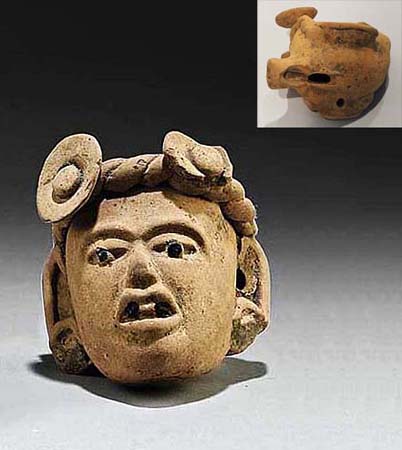
Owner: HWMC
Catalog#: LA-AEWF-28
Provenance: Collected by Ralph Fabacher and Higford Griffiths; to Alice Hogg Hanszen; to the Museum of Fine Arts, Houston, 1965; To HWMC, 2010
Edge Blown Flutes
Mexico ‘Veracruz Head Whistle’
Mexico
Veracruz Culture
Pottery, tar
ca. 600-900 CE
Height: 3 inches
Aerophones – Wind Instruments Proper – Edge Blown Flutes
A Pre-Columbian whistle from the Gulf Coast of Mexico, Veracruz (Vera Cruz) culture, ca. 600-900 CE. This hand-built buffware whistle depicts a disembodied human head with a twisted and ornamented headpiece. There are distinct facial features with black chapapote (tar) highlights and the mouth is open as if in speaking.
A whistle is an aerophone belonging to the flute family and within that classification it is a type of ‘duct’ flute. It is played by blowing air into a small duct (tube-like opening) which directs/channels the air to a sharp edge cut in the tube or on the side of the instrument, breaking the airflow into vortexes that spiral away from and into the instrument. A characteristic of whistles and ocarinas in an agricultural society such as the Veracruz culture, is the use of clay for these instruments that were molded from a single material into either zoomorphic (animal forms), and anthropomorphic (human form).
The role of the whistle has not been fully explored or documented in Mesoamerica; however, the care that went into making this instrument suggests it may have been a virtual instrument for conjuring up the supernatural, for protection in their religion and cultural beliefs. The Spanish colonists have noted the use of special shrines for musical wind instruments and the playing of ocarina-like whistles and flutes were used to announce ritual dancing and chanting.
